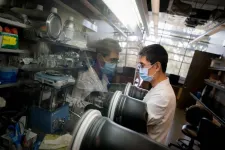(Press-News.org) Copenhagen, Denmark: Women treated for childhood Hodgkin lymphoma may face declining fertility at a younger age, according to research presented today (Monday) at the 39th annual meeting of the European Society of Human Reproduction and Embryology (ESHRE) [1].
The research also found that women treated for Hodgkin lymphoma may have to try for longer to become pregnant; however, the majority of women in the study who had tried to become pregnant were ultimately successful.
The research was presented by Dr Katja Drechsel from the Princess Máxima Centre for Paediatric Oncology, Utrecht, and Amsterdam UMC location VUmc (The Netherlands). She said: “Hodgkin lymphoma is a type of cancer that can affect children and young adults. Thanks to improvements in treatment, most people who are diagnosed with Hodgkin lymphoma now survive. However, we know that treatments such as chemo- and radiotherapy can lead to long-term side-effects, including lower fertility.”
The study included 84 women with an average age of around 30 who had been treated for Hodgkin lymphoma as children at an average age of around 13 years, as well as 798 women who had not been treated for Hodgkin lymphoma but volunteered to take part in the study.
Researchers asked the women whether they had children and how old they were when they became pregnant for the first time. They also tested the women for three markers of fertility in their blood (anti-Mullerian hormone, follicle stimulating hormone and inhibin B) and they used ultrasound to gauge the number of egg cells in the women’s ovaries (antral follicle count).
Among the women who had been treated for Hodgkin lymphomas in childhood, the levels of all three fertility markers in their blood were more likely to be abnormal compared to the women who had not been treated for Hodgkin lymphoma. The same was true for the results of the ultrasound scans, suggesting a lower number of egg cells remaining in the ovaries of the women treated for the disease.
The Hodgkin lymphoma survivors were also almost two and half times more likely to spend a year or longer trying before becoming pregnant for the first time.
The pregnancy rates and live birth rates were similar between the two groups; however, the women in the Hodgkin lymphoma group were two years younger on average when they had their first child (27 compared to 29 in the control group) and three years younger compared to the general Dutch population (average age 30).
Dr Drechsel explained: “Our results suggest that treatment for childhood Hodgkin lymphoma may have an impact on women’s fertility. In particular, they indicate that women’s fertility might decline at a younger age compared to other women. However, it’s encouraging to see that the women who have already chosen to start a family have been successful. On average they had their first child at a younger age, which may be because their doctors have spoken to them about the possible effects of their cancer treatment on fertility. We will need to follow this group for longer to see if they face greater difficulties becoming pregnant at older ages.
“These women were treated for cancer in the 1970s 80s and 90s. It’s important to note that treatment for childhood Hodgkin lymphoma has changed in recent years and the effects of current treatment schedules on fertility are likely to be less toxic.”
Dr Drechsel and her colleagues plan to follow the women to monitor their fertility in the longer term. They are also carrying out a larger prospective study (the fertility add-on study to the EuroNET-PHL-C2 trial) looking at signs of fertility in boys and girls treated according to the current European treatment protocol for Hodgkin lymphoma in five European countries.
The chair of ESHRE, Professor Carlos Calhaz-Jorge from the Northern Lisbon Hospital Centre and the Hospital de Santa Maria in Lisbon (Portugal), was not involved in this research. He said: “This study provides some reassurance for young women who have survived Hodgkin lymphoma as children. It shows that most of them who try for a baby do manage to become pregnant. However, the women in this study were relatively young and some of them thought it was too soon to start a family. This means it is too early to be sure about the long-term effects of treatment for this disease. More women need to be followed for a longer period of time.
“It’s important for women who have survived childhood cancer such as Hodgkin lymphoma to be aware that their treatment could have an impact on their fertility in the long term. Knowing this could help them choose to try for a baby at a younger age or take steps to preserve fertility, such as egg-freezing, to potentially help them to become pregnant later.”
(ends)
[1] Presentation no: O-083, “Ovarian reserve, Reproductive function and Pregnancy outcomes among Female survivors of childhood Hodgkin lymphoma: results from the DCOG LATER-VEVO Later study”, presented by Katja Drechsel, Session 25: Female fertility preservation: lessons learned so far, Auditorium 10-12, 16.00 hrs CEST, Monday 26 June 2023.
Notes for editors
According to the UK Academy of Medical Science’s press release labelling system, this is a non-peer reviewed observational study in people.
Funding: The VEVO-Later DCOG study was supported by the Dutch Cancer Society (Grant number: VU 2006-3622), and the Children Cancer Free Foundation (Grant Number: 20).
When obtaining outside comment, journalists are requested to ensure that their contacts are aware of the embargo on this release.
For further information, contact:
Kerry Noble
Email: kerry_noble@hotmail.com
Mobile: +44 (0)7446 869 433
Emma Mason
Email: wordmason@mac.com
Mobile: +44 (0)7711 296986
Sophie Goodchild
Email: goodchildsophie@hotmail.com
Mobile: +44 (0)7767 325595
Laura Rossignoli at ESHRE
Email: Laura@eshre.eu
Mobile: +32 (0)499 92 32 49
The European Society of Human Reproduction and Embryology (ESHRE) is a European non-profit organisation with international membership, whose main mission is to promote the study and research of reproductive science and medicine as well as the treatment of infertility. Established in 1984, the Society now comprises more than 9.000 members and has become the leading Society in reproductive science and medicine worldwide. Our members are medical professionals, scientists and researchers working in reproductive science, reproductive medicine and embryology. We work in close partnership with the patient organisation Fertility Europe. The ESHRE annual meeting attracts over 11,000 clinicians, researchers, scientists, exhibitors. In 2022, participants from 130 countries attended. Seven of the top ten countries represented were European.
END
Fertility may decline early in women treated for Hodgkin lymphoma in childhood, but most who try for babies when they are young are successful
2023-06-26
ELSE PRESS RELEASES FROM THIS DATE:
NSF invests $162 million in research centers to accelerate materials science from lab to factory
2023-06-26
A $162 million investment from the U.S. National Science Foundation will drive the creation of advanced materials capable of remarkable things — from being tough enough to withstand the heat of a fusion reactor to processing information at the quantum level. Nine Materials Research Science and Engineering Centers (MRSECs) will each receive $18 million over six years. The centers aim to transform fundamental scientific breakthroughs into tangible benefits for multiple sectors of the U.S. economy and innovations ...
Towards synthesis of phenanthridine-based pharmaceutical compounds
2023-06-26
Phenanthridines are heterocyclic compounds consisting of two six-membered benzene rings fused to a six-membered ring containing nitrogen. They are found in many naturally occurring organic compounds known for their anticancer and antitumor properties. Due to their potential medicinal applications, there is a significant interest in synthesizing phenanthridine derivatives in laboratories. A promising synthesis approach involves radical isonitrile insertion to produce imidoyl radical intermediates, which then cyclize to form phenanthridine. However, the exact mechanism of isonitrile insertion is not well understood.
Recently, a team of researchers, led by Associate Professor ...
Arsenic levels decline for most highly exposed U.S. communities served by public water systems following final arsenic ruling
2023-06-26
June 26, 2023-- Reductions in arsenic exposure among the U.S. population were reported for users of public water systems in the South and West, and among Mexican American participants, according to a new study by Columbia University Mailman School of Public Health. Differences in change over time were reported by educational attainment in addition to by region, race/ethnicity, and public water arsenic level. The full findings are published in the journal Environmental Pollution.
The Final Arsenic Rule, first enforced since 2006, reduced the arsenic maximum contaminant level to 10 μg/L in public water systems.
“We ...
No simple answer for why people believe in conspiracy theories
2023-06-26
People can be prone to believe in conspiracy theories due to a combination of personality traits and motivations, including relying strongly on their intuition, feeling a sense of antagonism and superiority toward others, and perceiving threats in their environment, according to research published by the American Psychological Association.
The results of the study paint a nuanced picture of what drives conspiracy theorists, according to lead author Shauna Bowes, a doctoral student in clinical psychology at Emory ...
Wiley and the European College of Sport Science announce partnership
2023-06-26
HOBOKEN, N.J. – June 26, 2023 – Wiley, a knowledge company and global leader in research, publishing and knowledge solutions, today announced that it will publish the European Journal of Sport Science (EJSS) on behalf of the European College of Sport Science (ECSS) beginning in January 2024, spearheading the journal’s transition to open access.
“EJSS is one of the preeminent multidisciplinary sport science journals,” said Allyn Molina, Vice President for Life Sciences at Wiley. “As a publisher at the forefront ...
A potential breakthrough treatment for cystic fibrosis enters clinical trial led by CI Med and U of Iowa researchers
2023-06-26
URBANA, Ill. – Clinical testing is underway for a potentially groundbreaking new treatment for cystic fibrosis. Pioneered by scientists at Carle Illinois College of Medicine at the University of Illinois Urbana-Champaign and the Carver College of Medicine at the University of Iowa in partnership with the spin-out biotechnology company, cystetic Medicines, this promising inhalable molecular prosthetic is intended to improve lung function in people with CF who cannot benefit from current therapies.
The launch of this clinical trial is an important ...
Ataxias: International Award for Bonn Patient Care and Research
2023-06-26
The Ataxia Center at the University Hospital Bonn (UKB) and DZNE have been awarded the title “Ataxia Center of Excellence” by the US National Ataxia Foundation (NAF) for their patient care and research – as the only organization in Europe. The foundation represents patient interests and is one of the world’s major non-governmental funders of ataxia research. These rare brain diseases are characterized by progressive loss of balance and coordination, accompanied by slurred speech. It is estimated that this condition affects around 16,000 women and men in Germany.
The NAF awarded the title “Ataxia ...
Men experience a long-term drop in semen quality after COVID infection – even if the infection was mild
2023-06-26
Copenhagen, Denmark: More than three months after suffering from mild COVID infection, men have lower sperm concentrations and fewer sperm that are able to swim, according to new findings presented today (Monday) at the 39th annual meeting of the European Society of Human Reproduction and Embryology (ESHRE) [1].
Professor Rocio Núñez-Calonge, scientific advisor at UR International Group at the Scientific Reproduction Unit, Madrid (Spain), said that after an average of 100 days following SARS-CoV-2 infection there appeared to be no improvement in sperm quality ...
Cheap and safe hormone treatment shows promise for couples with unexplained infertility
2023-06-26
Copenhagen, Denmark: A small study with couples experiencing unexplained infertility suggests that a hormone treatment could increase the chances of having a baby.
The trial, presented today (Monday) at the 39th annual meeting of the European Society of Human Reproduction and Embryology (ESHRE) [1], compared couples trying to conceive naturally with couples where the woman used a vaginal progesterone treatment during the second half of her menstrual cycle.
The researchers say a larger trial is now warranted but, given the treatment is safe and low-cost, it could ultimately benefit many people living with infertility around the world.
The study ...
50-million-year-old katydid fossil reveals muscles, digestive tract, glands and a testicle
2023-06-26
CHAMPAIGN, Ill. — 50 million years ago in what is now northwestern Colorado, a katydid died, sank to the bottom of a lake and was quickly buried in fine sediments, where it remained until its compressed fossil was recovered in recent years. When researchers examined the fossil under a microscope, they saw that not only had many of the insect’s hard structures been preserved in the compressed shale, so had several internal organs and tissues, which are not normally fossilized.
They describe their findings in the journal Palaeoentomology.
“Katydids ...


